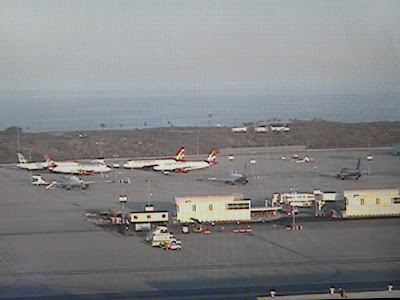One of the nice things about having a fleet of the same model of airplanes is that you can borrow parts off of one to fix another. I worked my way through school working as a lineman for an FBO, and we had a sizeable fleet of Cessnas. It was common practice to borrow a piece from one that was in the shop to use on one of the others. It's a process that's normally invisible to outsiders. But when all of your aircraft aren't painted the same, it can sometimes be blatantly obvious.
On large commercial aircraft, some of the most common pieces for swapping are the nose cones, which are usually made of fiberglass or some similar composite (i.e. non-metal) material. They aren't made of metal because the antenna for the aircraft's on-board weather radar is normally mounted in the nose, and the radar signal would be blocked by a metal nose cone - and thus they are also frequently called a "radome." Being at the very front of the aircraft, radomes often sustain impact damage, be it from a bird or a truck. They can also be damaged if the aircraft has to fly through heavy rain, or even worse, hail. Flying through a sandstorm doesn't do them any good, either. I've seen a couple from airplanes that were hit by lightning in flight. The lightning burns a hole in the radome, and there is usually a lot of other damage elsewhere as well (like a bullet from a gun, lightning normally produces an entry wound and an exit wound, with a good bit of carnage in between; unlike a gunshot, however, the two points are frequently not in a straight line):







Besides radomes, engine cowling pieces tend to get swapped often. I suspect that this happens because they get removed for engine maintenance, and then something happens to them while they're off the aircraft. In other cases, there maybe a bad hinge or latch that requires repair in the sheetmetal shop, and so a substitute part is installed in the interim:







These next two examples make more sense if I show you both sides of the aircraft. In each case, the first photo shows the mismatched parts, while the second shot illustrates the norm:




Less commonly, control surfaces may get swapped. Since most airline liveries don't include the wings or horizontal tail, these will normally be undetectable to the observer. The rudder, on the other hand, is easy to see:


Like some of the others, these shots make a little bit more sense if I also show you these, and explain that Airborne Express is ABX Air is DHL:


This last example was actually the inspiration for this entry:





























































